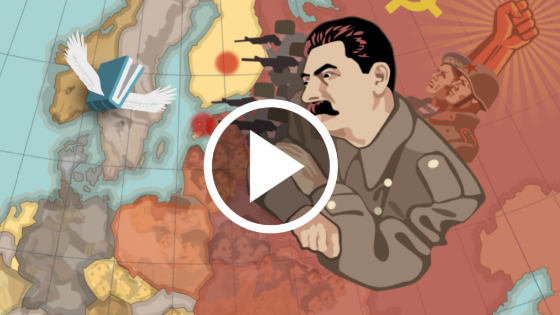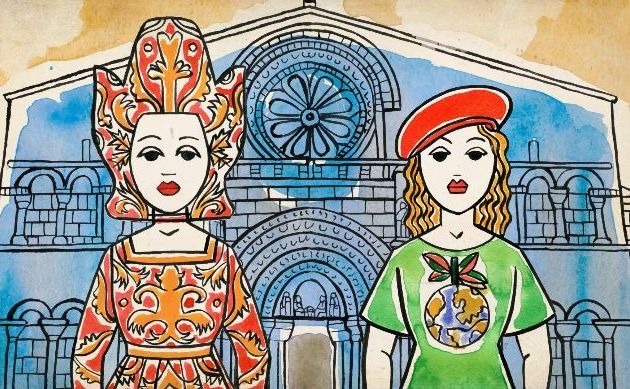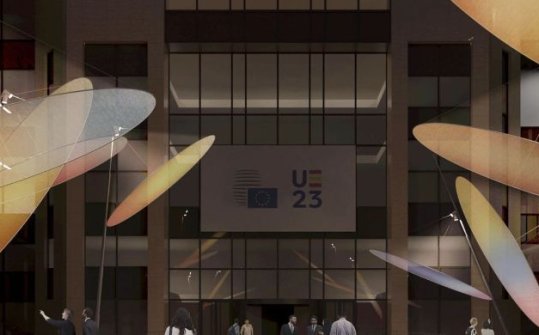pUEnte, Illustrated Encounters, is a set of 11 short animated pieces whose protagonists are musical instruments, traditions, arts and artists, stories and places that will make visible little-known and unique aspects that unite us as citizens of the European Union.
A project devised by Arrebato Libros for the Spanish Presidency of the Council of the European Union during the second semester of 2023, with the support of Acción Cultural Española and the General Directorate for Books, Comics and Reading of the Ministry of Culture and Sport of Spain. With the participation of the artists Álvaro Ortega, Cristina Daura, Grillante, Isidoro Valcárcel Medina, Javi de Castro, Laura Pérez Vernetti, María Medem, Miguel Brieva, Olga Capdevila, Ricardo Cavolo and Víctor Coyote; and the curatorship of Mauro Entrialgo. In addition, the musicians Diego Galaz, Germán Díaz, Javier Álvarez, Mariona Sagarra and specialists such as Joaquín López Bustamante, Karlos Aizpurúa, Óyeme Studio or Xose Ambás collaborate.
STORIES
1) 'THE GOMERO WHISTLE ('EL SILBO'). FROM LA GOMERA TO TYROL' | Olga Capdevila
The Silbo or Tyrolean Song originally had the objective of being the call cry that the mountain farmers emitted to communicate with their herds and with neighboring populations. In this animated piece, Olga Capdevila recreates a vocal journey between two of the most distant populations in Europe, a magical conversation that aims to make visible two of the most ancient communication systems on the continent.
Animation: Olga Capdevila
Silbo Gomero: Edison Manuel Sierra Medina
Sounds & effects: Daniel Moreno Roldán
Initial animation: Mauro Entrialgo
Final credits: Xavi Olmos
Graphic image: Alonso & Moutas
Naming and poetic orientation: Peru Saizprez
2) 'ACCORDION, FROM VIENNA TO BURGOS' | Víctor Coyote
The accordion, invented in Vienna at the beginning of the 19th century, quickly became the ideal instrument for popular music. It arrived in Spain through the Italian workers who worked on the construction of the northern railways. From that moment on, it was the instrument par excellence in parties and festivals, and with it came the dance in pairs, the "agarrao" dance.
Design, illustrations and animation: Víctor Coyote
Animation: Cesar Abanades
Music, sounds and effects: Diego Galaz
Initial animation: Mauro Entrialgo
Final credits: Xavi Olmos
Graphic image: Alonso & Moutas
Naming and poetic orientation: Peru Saizprez
2) ‘BERTSOLARIS, FROM THE ALPUJARRA TO CORSICA’ | Grillante
In this poem there are seven improvisation movements, such as “troveros”, “repentistas”, “regueifas”, “payadores” or “bertsolaris”. It’s a poem created by improvisation specialists who vary from the oldest person in Sierra de la Alpujarra to a seven-year-old Canarian girl.
This audiovisual piece, illustrated by Andalusian cartoonist Grillante and animated by Alfonso Benítez, portrays the living tradition of improvisation, taking us on a journey through the south of Europe whilst showing a 28-verse poem composed and told by seven different voices, each poet adding to the other’s preceding verses, very much like an exquisite cadaver.
Ilustraciones / Illustrations: Grillante
Animación / Animation: Alfonso Benítez
Música, sonidos y efectos / Music, sounds & effects: Laia Pedrol & Marc Serrats
Asesoramiento: Karlos Aizpurua Etxarte & Alexis Díaz-Pimienta
Animación inicial / Initial animation: Mauro Entrialgo
Créditos finales / Final credits: Xavi Olmos
Imagen gráfica / Graphic image: Alonso & Moutas
Naming y orientación poética / Naming and poetic orientation: Peru Saizprez
Trovero: Juan Morón
Mutetu Campidanesu: Paulu Zedda
Poeta Corsica: Pierre Santucci
Glosa: Laia Pedrol
Regueifa/Brindo: Alba María
Bertsolari: Haira Aizpurua Ibargarai
Repentista: Alba Guerra Ramírez
3) ‘VOSTELL MUSEUM, FROM LEVERKUSEN TO MALPARTIDA' | Isidoro Valcárcel Medina
Wolf Vostell, artista hispanoalemán de reconocido prestigio internacional, en 1976 llega de Leverkusen a Malpartida de Cáceres y funda el Museo Vostell, convirtiendo este Lavadero de Lanas en uno de los espacios fundamentales del arte de vanguardia europea.
Isidoro Valcárcel Medina, Premio Nacional de las Artes Plásticas, para su primera exposición en este museo, ha dibujado y expuesto un millón de puntos.
Artist: Isidoro Valcárcel Medina
Script, editing and music: Diego Rampellini
Music credits: Javi Álvarez
Acknowledgements: Alberto Flores, Arles Iglesias, Fabio de la Flor, Josefa Cortés, Jorge Álvarez, José Antonio Agúndez y Pilar Huete.
4) ‘HURDY-GURDY, FROM ALSACE TO FINISTERRE' | Miguel Brieva
This oneiric piece tells the story of how the hurdy-gurdy originated. This string instrument left its monastic and church settings to become a popular instrument amongst minstrels and troubadours. It was later played by pilgrims of the Camino de Santiago, and then became known throughout Europe.
In the 15th century it fell into decay, used only by beggars and blind people. In the 18th century it resurged, became fashionable again and became the entertainment of the European bourgeoisie and intellectuals, except in Spain, where it almost disappeared.
Nowadays, the hurdy-gurdy is slowly regaining its place in Spanish and European society through folkloric traditions.
Animation design: Miguel Brieva
Animation: Álvaro Espinosa
Music: Germán Díaz
Acknowledgements: Diego Galaz
6) ‘EU AGAINST DICTATORSHIPS’ | Álvaro Ortega
One of the most important missions of European Union is to ensure democracy and the rule of law, as well as to promote respect for human rights and fundamental freedoms.
To confront the hatred imposed by dictatorships of some parts of Europe and the rest of the world, education is the key. This short piece of animation aims to remind us of this history to avoid repeating the mistakes of the past.
Illustration & animation: Álvaro Ortega
Music: Olivier Messiaen “Cuarteto para el Fin de los Tiempos”
Translations: Ben Clark
Thanks to: Gonzalo Olabarría
8) ‘TRASHUMANCE, FROM SCANDINAVIA TO EXTREMADURA’ | María Medem
In today’s Europe, there are only two regions in which long-distance seasonal movement of livestock continues: in the region of Scandinavia with the transhumance of reindeer and in the Iberian Peninsula with sheep.
In Spain, each nomadic sheep carries around 5000 seeds each day, thus connecting ecosystems, alleviating climate change and keeping a traditional culture and wisdom alive. This story tells the symbolic journey of a Birch seed from the Scandinavian Alps to Extremadura.
Illustration: María Medem
Animation: María Medem
Music: Diego Galaz
Acknowledgements: Centro de Acercamiento a lo Rural, Campo Adentro
9) ‘EUROPE HAS A GYPSY SOUL, FROM ALGECIRAS TO ISTANBUL’ | Ricardo Cavolo
Since their arrival from northwest India to Europe in the 13th century, and with a current European population of about 8 million people, gypsies are the largest minority in the European Union.
Although the Gypsy people arrived in Europe centuries ago, today they continue to suffer a strong discrimination and social rejection, enduring a situation of generalized exclusion.
This piece narrates their arrival on the continent, the horror of the Nazi holocaust, the first World Romani Congress in London in 1971 that established the Gypsy flag and anthem, and serves as a tribute to relevant artists such as Django Reinhardt, Camarón de la Isla or Carmen Amaya.
Illustration: Ricardo Cavolo
Animation: Óyeme Studio
Script: Joaquín López Bustamante
Music: “Casablanca” Fanfare Ciorcalia
10) 'AGUILANDEIROS, FROM GRAU TO SUCEAVA’ - Javi de Castro
The Aguilandeiros de San Xuan is a winter masquerade like many others on the peninsula and in much of Europe. This winter solstice tradition brings masked characters that walk the streets of villages asking for a Christmas present.
Though many of these masquerades were lost decades ago, since 2014 the testimonies of the elderly people of the village of Parroquia San Xuan de Villapañada, in Asturias, have helped recover the presence of the Aguilandeiros. Thanks to this recovery effort, many of these elderly people have been able to live the ancient tradition again.
Grau boasts a large Romanian community that has embraced this tradition, which is very similar to some Romanian masquerades that have the same characters, such as the bear.
IIllustration: Javi de Castro
Animation: Javi de Castro
MMusic: ATOAM ( Archivo de la Tradición Oral d’Ambás) y Producciones de La Piedra, Xixón.
Original idea: ATOAM
Voice of the Romanian girl: Sofia Diana Kanyuka Kanyuka
VVoice of the Asturian woman: Tere de la Fuente Álvarez. (Rozadas, Grau)
Linguistic revision: Ramsés Ilesies
We wish to thank: Vecinos y Aguilandeiros de San Xuan de Villapañada. Conceyu de Grau.
11) ‘THE CANT DE LA SIBIL.LA, FROM ATHENS TO MALLORCA' - Laura Pérez Vernetti
The Sibiŀla is a wise woman believed to embody a prophetic spirit. Her voice foretells the fate of the year accompanied by a choir and ancient instruments. Even though it is a pagan ritual, this song is typically performed on the night of December 24, before the Midnight Mass, in churches and cathedrals in Catalonia, the Balearic Islands, Valencia, Sardinia (Alghero) and French Roussillon.
Declared Intangible Cultural Heritage of Humanity by UNESCO, the Cant de la Sibiŀla survives in tradition as a song of remote and unknown origins.
Sheltered in a corner of the Mediterranean, her voice passes through us like an oracle announcing the Apocalypse over a period of ten centuries. In this audiovisual piece, Sibiŀla chants revealing the great problems that Europe is currently facing, such as war or climate change.
Illustration: Laura Pérez Vernetti
Animation: Óyeme Studio
Music: Mariona Sagarra


















